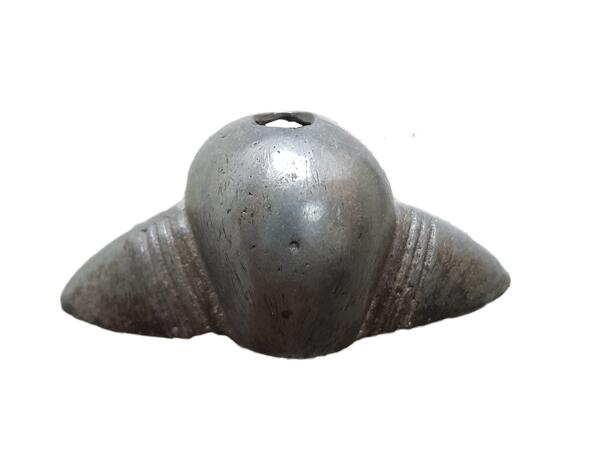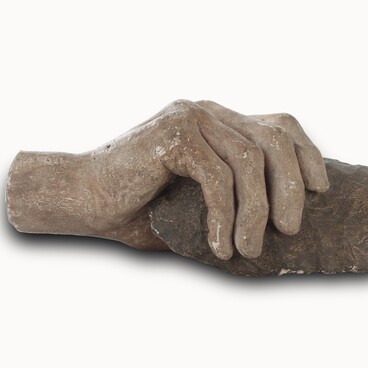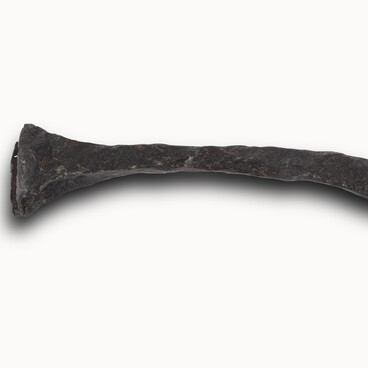The fragment of the pommel of an Old Russian sword entered the collection of the Kursk State Regional Museum of Archaeology in 2010. It was found on the left bank of the Psyol river, on a sand dune near the northern outskirts of the village Khomuttsy of the Ivnyansky district of the Belgorod region, near the administrative border between the Kursk and Belgorod regions.
The find is the upper part of a sword pummel. The tripartite billon pommel has a high domed middle part, separated by bands of four deep engraved lines from the two lateral lobes smoothly descending to the edges. A round hole is made at the top of the middle part, probably for attaching the pommel to the hilt of the sword. On the edges of the lower part of the head there are two small rounded protrusions, one of which has a lengthwise recess.
The pommel from Khomuttsy was located four kilometers straight from the Gochevsky archaeological complex (Belovo district, Kursk region). It is the site where a fairly representative and typologically diverse collection of weapons of the late 10th — 14th centuries comes from. Part of the Gochevsky weaponry can most probably be attributed to the armament of elite warriors. Billon alloy used in casting the pommel from Khomuttsy is also likely to be indicative of wealth and a high social status of the sword’s owner. Therefore, it is possible to assume that the pommel from Khomuttsy crowned a sword hilt that belonged to a noble Russian warrior who lived in the 12th — the first half of the 13th centuries on the territory of the Gochevsky archaeological complex, one of the southern border fortresses of the Kursk principality.
The Kursk historian Andrei Gennadyevich Shpilev refers to a stylistically similar find from the Belgorod region — a sword pommel from Vozdvizhenskoe, formerly Kostroma province. The sword on display is kept in the Kostroma Museum and was studied by Anatoly Kirpichnikov, an archaeologist and specialist in ancient weaponry. He attributed this weapon to the late ancient Russian swords of type 2: swords of this type had a three-part bronze or iron pommel, and usually a slightly curved crossguard, which was more suitable for striking and fighting on horseback. According to the historian, the shape of the hilt of type 2 swords indicates probably their eastern European origin. The oldest of such swords is dated to the 11th century, the latest one — to the second half of the 13th century at the earliest.
The find is the upper part of a sword pummel. The tripartite billon pommel has a high domed middle part, separated by bands of four deep engraved lines from the two lateral lobes smoothly descending to the edges. A round hole is made at the top of the middle part, probably for attaching the pommel to the hilt of the sword. On the edges of the lower part of the head there are two small rounded protrusions, one of which has a lengthwise recess.
The pommel from Khomuttsy was located four kilometers straight from the Gochevsky archaeological complex (Belovo district, Kursk region). It is the site where a fairly representative and typologically diverse collection of weapons of the late 10th — 14th centuries comes from. Part of the Gochevsky weaponry can most probably be attributed to the armament of elite warriors. Billon alloy used in casting the pommel from Khomuttsy is also likely to be indicative of wealth and a high social status of the sword’s owner. Therefore, it is possible to assume that the pommel from Khomuttsy crowned a sword hilt that belonged to a noble Russian warrior who lived in the 12th — the first half of the 13th centuries on the territory of the Gochevsky archaeological complex, one of the southern border fortresses of the Kursk principality.
The Kursk historian Andrei Gennadyevich Shpilev refers to a stylistically similar find from the Belgorod region — a sword pommel from Vozdvizhenskoe, formerly Kostroma province. The sword on display is kept in the Kostroma Museum and was studied by Anatoly Kirpichnikov, an archaeologist and specialist in ancient weaponry. He attributed this weapon to the late ancient Russian swords of type 2: swords of this type had a three-part bronze or iron pommel, and usually a slightly curved crossguard, which was more suitable for striking and fighting on horseback. According to the historian, the shape of the hilt of type 2 swords indicates probably their eastern European origin. The oldest of such swords is dated to the 11th century, the latest one — to the second half of the 13th century at the earliest.



